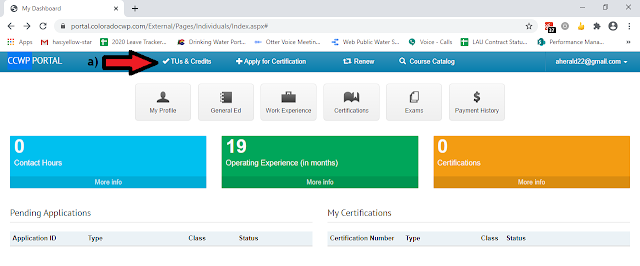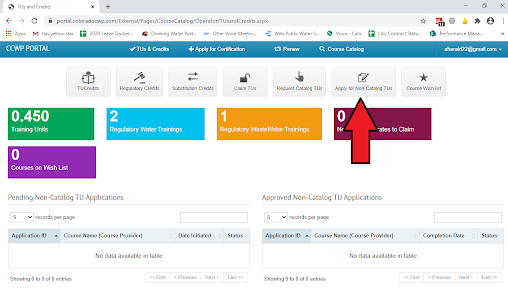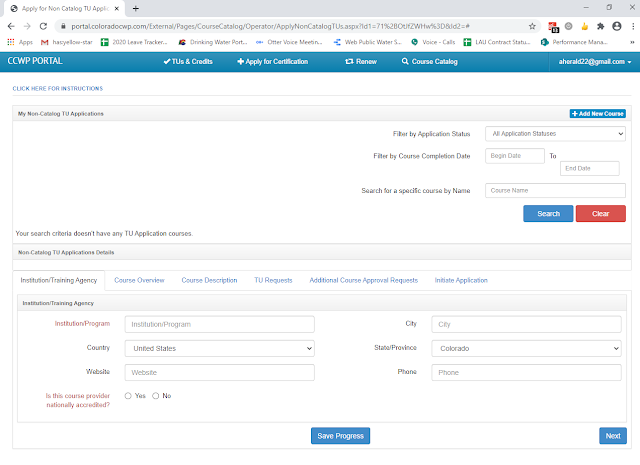Hello everyone,
I recently unearthed the article below from the Aquatalk archaeological dig site and radiocarbon-dated it to 2010. This article was from the bygone days when we actually mailed out hard copies of the newsletter to all subscribers. It was a retrospective look at the 2000s and a look ahead to the 2010s. I thought it would be fun to republish now and then in a future message, we can look back at what actually happened in the 2010s and look forward to the 2020s as well. Thank you for all you do to keep tap water safe in Colorado!
Perspectives on a New Decade
Originally published Spring 2010
As we close out the 2000s and head into the 2010s, I wanted to offer some perspective on where the Safe Drinking Water Program in Colorado was in 2000, where we stand today, and what the future portends. I believe that the last decade solidified the value and viability of the Safe Drinking Water Program in a number of ways. However, as we enter 2010 we are still trying to address some long-standing challenges and improve our ability to implement an effective program into the future.
In 2000, Colorado was far behind in adopting and implementing new drinking water rules following congressional re-authorization of the Safe Drinking Water Act in 1996. Specifically, Colorado did not adopt any of the new rules on time, and received extensions from EPA. In some cases, the extensions almost expired before we adopted the rule.
This situation created a great deal of concern for EPA, the state, and public water systems. The concerns centered around whether Colorado would or could maintain program primacy and the impacts of losing primacy including loss of flexibility, loss of field presence, and loss, of the now $24 million annual capitalization grant under the drinking water state revolving fund. Additionally, there was a great deal of uncertainty on the part of public water systems regarding how these new rules would be implemented in Colorado.
Fortunately, the Safe Drinking Water Program gained support and financial resources from all of our funding partners. Specifically, additional funding was provided by:
- federal funding in the form of set asides from the capitalization grants
- support from the Colorado Water Resources and Power Development Authority
- general fund increases from the state Legislature
- fees from public water systems
During the last decade everyone stepped up to the plate and helped ensure that this program would continue to benefit the citizens and visitors of Colorado. By 2005, Colorado had caught up with adopting required regulations, and we have since continued to adopt new regulations in accordance with EPA deadlines. Although today the Safe Drinking Water Program does not have resources to adequately implement the new regulations into the 2010s, the dire situation of 2000 has improved substantially. Furthermore, as we have added resources to the program, I believe that we have struck a balance by adding engineers, compliance officers, enforcement staff and personnel specifically devoted to helping public water systems strengthen their technical, managerial and financial capacity.
The 2000s brought unexpected events as well, including the terrorist attacks of September 11, 2001, and the Alamosa Salmonella outbreak in March 2008. In response to our threatened national security, federal, state and local agencies enhanced their crisis response readiness, and public water systems assessed their security vulnerability. Working with stakeholders from around the state, the Colorado Water/Wastewater Agency Response Network (CoWARN) was established in 2007 so that utilities could effectively assist each other in time of need. CO-WARN was put to good use during the Alamosa outbreak. The overall outbreak response, subsequent investigation and efforts going forward in the aftermath are enormous. We all became more aware of the potential for and consequences of waterborne disease. As a result, the Safe Drinking Water Program has intensified efforts and developed new strategies to reduce the likelihood of disease outbreaks in Colorado that are associated with public water systems.
So in early 2010 I wonder what the next decade will bring. Will we be able to effectively implement the regulations adopted in the late 2000s? What new regulations will be promulgated by EPA before 2020?
What progress will be made in understanding and dealing with pharmaceuticals, personal care products, and other unregulated contaminants in drinking water?
What additional precautions will water utilities need to take as part of our nation's efforts to protect the homeland? What about climate change impacts? Will we be able to address the need for billions of dollars of investment in infrastructure? Surely, unexpected challenges will arise as well.
One thing is certain. Water utilities and the Safe Drinking Water Program will continue to struggle with resource issues related to personnel (aside from staffing levels, consider the percentage of our workforce nearing retirement), financial sustainability, and/or aging infrastructure. As I say all the time, safe drinking water does not just happen. In fact, drinking water is not safe without the hard work and dedication of public water system personnel and the necessary financial support of their customers.
Continuously safe drinking water is absolutely the public's expectation. Whether safe drinking water is a right, or not, is a philosophical discussion for debate. More often than not, it is viewed as a basic right. In the face of such expectations and challenges, I believe that we must strive to educate the public so that our services are appropriately valued. Improving public awareness of the Safe Drinking Water Program and the efforts of public water system operators and managers is certainly one of my goals for the 2010s.
Only time will tell what I (or my successor) will write in this space in 2020 while reflecting on the 2010s. Let's all work together to ensure that the message will be a positive one!
Thank you.
➽ Ron Falco, P.E., safe drinking water program manager
















